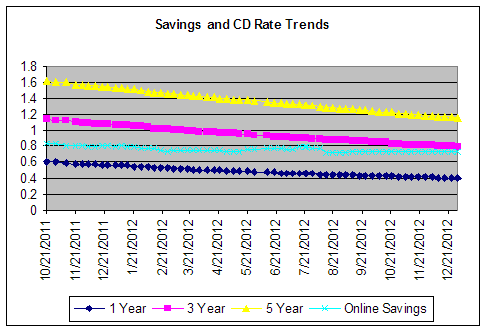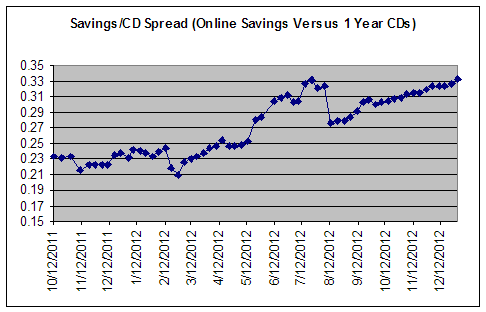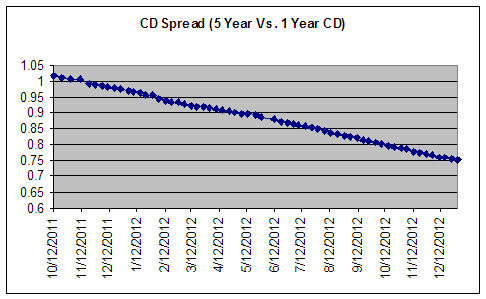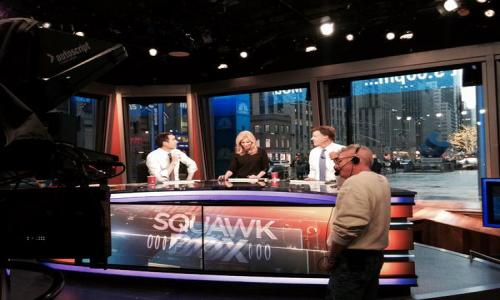Happy New Year! I thought I would use the inspiration provided by the new year to take a look ahead and make some projections about what I expect to happen to rates over the next 12 months. First, let's see where savings rates ended in 2012.
As the chart below shows, 2012 was the year of the steady decline. One year average CD rates started the year at 0.56% APY and finished the year at 0.41% APY. Five year CDs dropped more, going from 1.53% APY to 1.159% APY. Only online savings rates somewhat held their ground, with the average moving from 0.795% APY to 0.737%.

The difference in the rate of decline between online savings and CD rates can be viewed on the chart below, which shows the spread between online savings account rates and 12 month CDs. By the end of 2012, online savings accounts on average paid .33 percentage points more than 1 year CDs, up from .23 percentage points more at the beginning of the year.

The two things to consider looking ahead to 2013 is what will happen to rates in general, and what will happen to the rates of individual products?
General rate environment
Rates will continue to gradually move lower in 2013. My reasoning includes::
- The Fed has committed to keeping rates exceptionally low as long as unemployment is above 6 1/2 percent. It currently stands at 7.9%. At the current rate of decline, it will take at least 2-3 years to get to 7.9%. If the economy picks up, it could get there sooner.
- The economy has picked up a bit of steam in the last couple of quarters. But GDP growth of 1-2% will not be enough to quickly bring down the unemployment rate. I project steady but moderate economic growth of around 2.5% in 2013.
- Bank are awash in cash from individuals and corporations and do not need more deposit dollars. Third quarter 2012 FDIC data showed banks had over $9 trillion in deposits, up from $8.5 trillion in the third quarter of 2011. Many banks are having trouble figuring out how to deploy their cash. Part of this is because of lending fears and credit quality and the other part is to do increased governmental oversight.
- Demographic trends are unfavorable. Unfortunately, the United States has entered a demographic slide. As the large baby boom generation ages and retires, this puts a large strain on the country's productivity and spending. I believe that demographics is a general driver of economic development. A young population lifts all boats. An aging will leave quite a few boats stranded and make it difficult for the others. Japan and Europe have even worse demographic problems and their economies reflect that. As China's population ages, look for its growth to ebb. This demographic slide will be a factor for the next ten to twenty years, not stopping growth, but certainly acting as a headwind.
Do I think the situation is hopeless? No. Even amidst this slow growth, relatively depressed environment, progress is occurring. The world overall is becoming richer, new technology is being developed, and ideas and businesses are taking root. I'm a bit more optimistic than the Fed that advances in communication, energy, transportation, healthcare, and other areas will boost growth sooner rather than later. Humans are an adaptable lot and ingenuity will help to mitigate many of these problems - just not this year.
The Fiscal Cliff
As I write this, the House and Sentate have just passed bills that would help ease the United States off the fiscal cliff - sort off. Taxes will go up on those that make $400,000 individually or $450,000 filing jointly. Payroll taxes will go up 2% on everyone, and unemployment benefits will continue indefinitely. No grand bargain emerged and difficult discussions on spending remain. The bills delay cuts from sequestration for two months so that the President and Congress can try to come up with a different way to cut.
The current fix is the type of half solution I expected, although I must admit I thought they would simply put a fix in place for another year as opposed to making the tax cuts (or tax increase depending on your income) permanent.
Either way, the last-minute solution is, in my opinion, neutral in its impact on economic growth or rates.
My outlook: Savings rates will continue to drift lower for the next 12-18 months before beginning to move higher. How high and how fast they move will depend on the government's ability to stop bickering and put a sound budget in place, the continuation of a recent economic uptick, technological advances, and the ability of Europe to put its woes behind it and resolve its fiscal problems.
Check in every week for a discussion of these factors are changing and how they impact my rate forecast. Feel free to comment with your thoughts below.
Savings Accounts or CDs?
The data still show that opening a savings account is a better bet than a 1-3 year term CD and I expect this to hold through 2013. Longer maturity CDs (3 years +) will continue to drop more than shorter maturity CDs and online savings accounts. The chart below shows that online savings rates have become increasingly competitive versus 1 year CDs and by extension 3 year CDs. I expect that trend to continue as longer maturity CDs come down more than shorter.
So for now, here are my recommendations:
For money you want to keep liquid, go with online savings accounts. They offer better rates than 1-3 year CDs and have shown good rate stability over the past year.
For longer-term money, look to open 4-5 year CDs at local community banks. BestCashCow research has shown that community banks and credit unions offer the most competitive rates on longer-maturity CDs.
I believe this is the best and easiest strategy for keeping your cash liquid and maximizing your savings over the next year.

Make the best of a tough savings situation in 2013
Yields may be low in 2013 but a savvy saver can boost the return with no increase in rate by rate shopping. By shopping around, a saver can earn an extra half to full percentage point. On $100,000, that's $1,000 in extra cash per year. Remember, even in today's environment, there is competition for your cash.
As always, I welcome your thoughts and comments.













Add your Comment
or use your BestCashCow account